|
|
THE
SPAGHETTI WESTERN GENRE,
Part 2
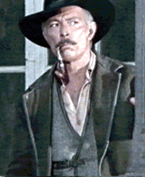
Correspondent Lee Broughton is an avid British cinema fan with a special itch
for the Italian Western, a dormant genre whose influence
is felt in every action movie today. Besides
the three Eastwood Leone films, only a pair
of Django films have come out on DVD here in the states ... and in
England the pickings are even slimmer. If there ever was a genre category
ripe for renewal, here it is. - GE4/29/00
Don't miss Part One of this Spagehetti
Westerns article.
Leone's influential Per qualche dollaro in piu (For a Few Dollars
More,1965), added to the
Spaghetti Western blueprint the pairing of cocky young gunfighters with older,
more experienced gunfighters, and flashback-fuelled vengeance. Leone's
assistant director on For a Few,
Tonino Valerii, came up with I giorni dell'ira (Day of
Anger,1967) in which Scott Mary (Giuliano Gemma), a young and socially
undervalued street cleaner, is taken under the wing of an old, but
ruthless, gunfighter called Frank Talby (Lee Van Cleef). Leone's noted
designer, Carlo Simi, designed the costumes for this feature. In the
same year Giulio Petroni directed the epic Da uomo a uomo (Death
Rides a Horse) in which Bill (John Phillip Law), the only survivor of a
callous massacre which prompts flashbacks, and Ryan (Lee Van Cleef), a
gunfighter who has just been released from jail, find themselves hunting
the same quarry. Luciano Vincenzoni (who wrote for both For a Few
Dollars More and The Good, The Bad & The Ugly) worked on the script
and Ennio Morricone provided an outstanding musical score. These
'pairing of gunfighters' vehicles can be really cool. Check out the end
of Tarantino's Pulp Fiction, where John Travolta and Samuel L. Jackson
nonchalantly saunter out of the eatery to the strains of Morricone style
Rock'n Roll guitar music for a diluted snapshot of what I'm getting
at.
Flashback-fuelled vengeance also appeared in Oggi a me....domani a
te (Today It's Me....Tomorrow You,1968), which was directed by
Tonino
Cervi. It's a kind of Spaghetti Western take on The Magnificent Seven
and stars Bud Spencer, William Berger and Tatsuya Nakadai (who had
actually appeared in The Seven Samurai).
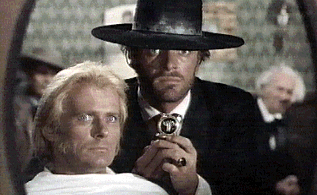
Sartana (Gianni Garko) and Laskey (William Berger) reflect upon the
significance of a musical pocket watch in Sartana.
Leone's Il Buono, il brutto, il cattivo (The Good, The Bad & The
Ugly, 1966), provided two further key elements for the ever-expanding
Spaghetti Western blueprint: the convoluted treasure hunt for a stolen
fortune, and the notion of ever-changing,
untrustworthy partnerships. Director Gianfranco Parolini hit a rich
seam, releasing four stylish films of quality that followed
variations of this pattern: Sartana (1968), starring Gianni Garko,
William Berger, Klaus Kinski and Fernando Sancho, Sabata (1969),
starring Lee Van Cleef and William Berger, Adios, Sabata (1970),
with Yul Brynner and Dean Reed and The Return of Sabata (1972),
starring Lee Van Cleef and Reiner Schone. Writer Bob Hiott put together
a nice article which, after studying Parolini's approach, granted him
the kudo of being the 'Sagebrush Fellini'.
In 1967, Giulio
Questi directed Se sei vivo spara (Django, Kill....If You Live,
Shoot!), an eccentric, slightly psychedelic and surreal but powerful, if
disturbing, assessment of human greed. Director and genre fan Alex Cox
noted that, 'at times it switches genres, from a Western into like a
Mario Bava horror film.'
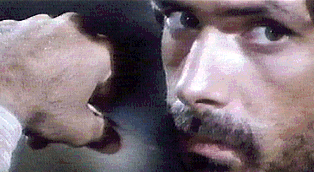
Tomas Milian in Django, Kill....If You Live,
Shoot!
Sergio Corbucci added a political slant when he
directed Companeros (1970), in which a mercenary (Franco Nero) and a
revolutionary bandit (Tomas Milian) agree to rescue a political
prisoner, who also happens to be the only person who can open a safe
that reputedly contains a 'fortune', all while being pursued by Jack
Palance's sadistic bounty killer. Featuring another great Morricone
score, it's a kind of companion piece to Corbucci's slightly straighter
'political' Western, A Professional Gun (The Mercenary,1968),
which Luciano Vincenzoni helped to script.
This film stars Franco Nero, Tony Musante and Jack Palance and features
a truly excellent Leone-style final duel and yet another rousing
Morricone score. The 'Political Spaghetti'
subgenre actually began
in 1966 with the release of Damiano Damiani's Quien
Sabe? (A Bullet For The General), which details the sly way
in which a
Gringo mercenary (Lou Castel) dupes a naive bandit (Gian Maria Volonte)
into inadvertently betraying the Revolution. Carlo Lizzani's
Requiescant (Kill And Pray,1967), starring Mark Damon and Lou
Castel, is a strange, slightly psychedelic, entrant in the 'Political
Spaghetti' stakes.
Most Spaghetti Westerns, by their very nature, could
be described as 'political' to some extent: you're hard pushed to find
an honest or honourable town official, businessman or authority figure
in any of these films. But some directors used the backdrop of the
Mexican Revolution to deliver a more explicit political message,
presented in an allegorical manner that didn't get in the way of the
action. The Wild Bunch, Sam Peckinpah's masterful response to the
European Westerns, and Sergio Leone's
Giu la testa
(Duck You Sucker, aka A Fistful Of Dynamite,1971) both give
a good idea of the
historical look and some of the situations encountered in these Mexican
Revolution-based films.
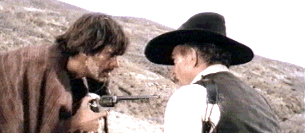
Cuchillo (Tomas Milian) gets the drop on Corbett (Lee Van Cleef) in
The Big Gundown.
Other directors used allegories which
highlighted the misuse of money, power, influence or intellect. Director
Sergio Sollima, former Leone scriptwriter Sergio Donati, designer Carlo Simi and Ennio
Morricone teamed up to produce two classics in this mould: La Resa Dei
Conti (The Big Gundown,1966) which starred Lee Van Cleef, Tomas
Milian and Walter Barnes, and Faccia A Faccia
(Face To Face,1967),
which starred Gian Maria Volonte, Tomas Milian and William Berger.
Leone's unique C'era una volta il West (Once Upon a Time in
The
West,1968) prompted others to examine new approaches too. Sergio
Corbucci went ahead and directed one of the most original and, just
possibly, the best Spaghetti Western ever, Il grande silenzio (The Big
Silence,1968). Set in the snow region, the film pits Silence (Jean
Louis Trintignant), a mute gunslinger deadly with a Mauser
automatic pistol, against a gang of vicious bounty killers, led by Loco
(Klaus Kinski). The use of the Mauser prompts some extremely fast gunplay,
with the choreography and editing resembling Sam Peckinpah's, as
it might have looked if presented in real time. The sets and costumes are
outstanding and Ennio Morricone provides one of the most evocative
soundtrack scores of his entire career. Clint Eastwood was rumoured to
have been interested in buying the remake rights. Certainly the Mauser
and a 'Silence' style hat made an appearance in Joe Kidd but there's
really no comparison.
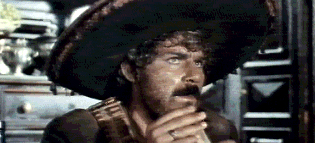
Gian Maria Volonte as El Chuncho
in A Bullet for the General.
Tonino Valerii directed the stylish but unusual
Il prezzo del potere (The Price of Power) in 1969. Disregarding
historical fact, the story concerns the plot surrounding the killing of
a President who visits Dallas in 1890, the subsequent framing and murder
of the accused killer and William Willer's (Giuliano Gemma) endeavours
to take on the conspirators and reveal the truth. Also in 1969, director
Sergio Garrone filmed the impressive and spooky Django il
bastardo (Django The Bastard). Starring Antonio De Teffe, the
unique
angle of this film is the fact that the victims of Django's vengeance
believe that he is in fact a ghost. Said to have been the influence
behind Clint Eastwood's High Plains Drifter, there's some excellent
camera work and cinematography on display as Django slides in and out of
frame with supernatural ease.
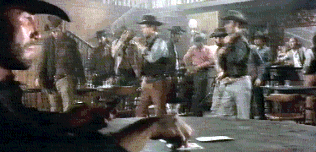
Antonio De Teffe deals another hand as
Django The Bastard.
In 1966, a friend and colleague of Sergio Leone, Giuseppe Colizzi
directed Dio perdona....io no! (God Forgives, I Don't). By casting
Mario Girotti/'Terence Hill' and Carlo Pedersoli/'Bud Spencer' as the
joint leads (along with Frank Wolff), Colizzi created one of the most
successful double acts in movie history. Two sequels, I quattro
dell'Ave Maria (Ace High,1967) and La collina degli stivali
(Boot
Hill,1969), followed. While Boot Hill pitted Spencer and Hill with
Woody Strode and Lionel Stander in a battle against Victor Buono's bad
guys, the best film of the trilogy, the epic Ace High, teamed our
heroes with Eli Wallach (in a marvellously 'Tuco'-like role). Although
slightly tongue-in-cheek, these films had more in common with Leone-style
straight action films than comedies. But, in 1970, Enzo Barboni
cast Terence Hill and Bud Spencer in Lo chiamavano Trinita (They Call
Me Trinity), an entertaining but slapstick and over-the-top comedy
Spaghetti Western. It was a boxoffice smash and a sequel, Continuavano
a chiamarlo Trinita (Trinity Is Still My Name.1972), was an even
bigger success.
Suddenly, almost every new Spaghetti Western seemed to be a
silly and boisterous comedy. Even Leone felt compelled to enter the
fray, producing two superior Terence Hill vehicles: Tonino Valerii's Il
mio nome e nessuno (My Name Is Nobody,1973), which also starred
Henry
Fonda; and Damiano Damiani's Un genio, due compari, un pollo (A
Genius,
Two Friends and an Idiot, aka Nobody's The Greatest,1975), which
also starred Patrick McGoohan.
In a desperate attempt to halt the decline of the Spaghetti Western,
the 'East meets West' subgenre was created, wherein various Eastern heroes visit the Wild West and, in at least one case, vice versa. An audacious but inspired attempt to merge the Spaghetti Western with the newly popular Martial Arts genre, Lee Van
Cleef and Lo Lieh appeared in the most famous variant, Antonio Margheriti's
La dove non batte il sole (The Stranger And the
Gunfighter,1973).
Rejecting both comedy and kung fu, the genre returned to form with Enzo
G Castellari's classic Keoma (1975). Featuring art direction by Carlo
Simi, it's an original and almost mystical Western, starring Franco
Nero, William Berger and Woody Strode. Castellari was thrilled when a
young reviewer correctly noted, 'this movie jumps from the present to
the past with the style of John Ford and Sam Peckinpah'. The interesting
time-flips and cuts might well have been another inspiration for
Tarantino. Sergio Martino then directed the equally excellent
Mannaja (A Man Called Blade) in 1977, a classic in the
stranger in
town/flashback-fuelled vengeance mould.
It proved to be a fitting film
with which to draw a line under the genre. Individual Spaghetti Westerns have
surfaced and have been warmly welcomed by genre fans in the years since
1977 but there have been no signs of a major revival. Maybe that
situation could change if these films are given the chance they
deserve, on DVD.
Don't miss Part One of this Spagehetti
Westerns article.
Also, Lee Broughton recommends this Spaghetti Westerns page for more details and some nice stills from
the films.
Spaghetti Text © Copyright 2000 Lee Broughton
DVD Savant Text © Copyright 2007 Glenn Erickson
|












